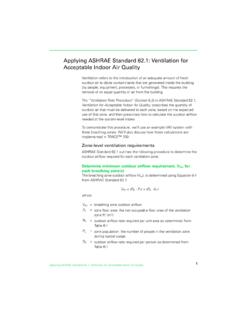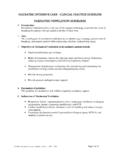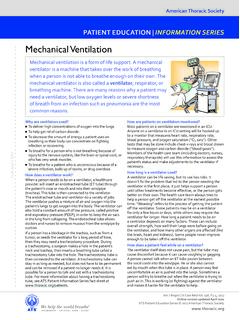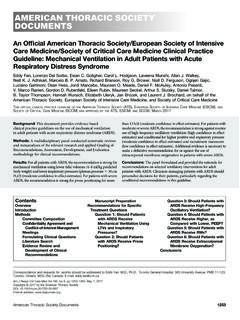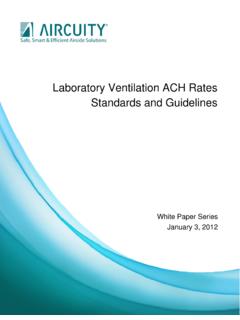Transcription of Fundamentals of Venting and Ventilation
1 Pub. No. 34-4010-02 American Standard Inc. 1993 Fundamentalsof Venting andVentilation Vent System Operation Sizing, Design and Applications Installation and Assembly Troubleshooting1 ContentsSubjectPage Motive force in vents ..2 Factors affecting operation ..3 Ventilation air requirements ..4 Vent design considerations - ..6 Category I furnaces ..6 Category II furnaces ..6 Category III furnaces ..6 Category IV furnaces ..7 Types of vents ..7 Vent classifications ..7 Vent materials ..9 Vent system design configurations ..9 Single appliance natural draft ..9 Multiple appliance single story common Venting ..9 Manifold Venting ..11 Multi-story vent systems ..11 Sizing and Design ..13 Category I furnaces Single appliance w/masonry chimney ..13 Single appliance Type B vent .. 14 Multiple appliance single story vents- common Venting .. 16 Multi-Story Vent Systems - common Venting .
2 17 Vents in high altitutde locations .. 19 Power Venting .. 19 Category II furnaces .. 19 Category III furnaces .. 20 Category IV furnaces .. 21 Combustion and Ventilation Air .. 22 Confined space .. 22 Unconfined space .. 23 General Installation .. 24 Safeties and Accessories .. 27 Prohibited Installations .. 28 Troubleshooting .. 30 Appendix Vent System Design Tables .. 32 Glossary of Terms .. 37 Portions of the text and illustrations in this book are used by permissionof the copyright holder, American Gas and VentilationWhen man first began to burn fuel for warmth, he soonlearned that the smoke, created during combustion, causedproblems when it was allowed to collect at the source. Hisearly caves were selected and later lodges were constructedwith an escape for these unpleasant fumes. As he beganto employ natural gas as a fuel, he continued to use whathe had learned.
3 Today, we still find that proper vent systemoperation is vital to safe and efficient furnace this manual, we will discover the things which are neededto provide this vent system. We will also learn that a gas furnace requires a substantialamount of fresh air to operate properly. This is calledventilation air. This air is used in combustion and as a re-placement for the air that a modern home loses throughoutward flow due to mechanical Ventilation . Although wecannot control the loss of air, we can properly diagnoseit if it becomes a problem and suggest following topics are covered in this manual: How a natural draft (gravity) vent works. Fan assisted vent systems. Power Venting . Sizing and designing vent systems. Supplying adequate amounts of fresh air forventilation. Vent system installation. the guidelines in this book can help to ensure safeand reliable vent performance for both natural draft andfan assisted : No two installations are alike!
4 Take the timeto study each application. Plan ahead, use goodjudgment, and always comply with national, state,and local sacrifice safety for efficiency or easeof installation!Motive Force in VentsWhat causes a natural draft vent to operate? Heat! As weall know, heat rises. This is because heated molecules havea tendency to become agitated and to move about. Be-cause of all this motion, the molecules bump into eachother creating more space in between them. See Figure1. This makes the substance less dense - lighter. Referringto Figure 1: As heat is applied to the air inside the balloonit expands and becomes lighter. When enough heat is applied,the balloon will become lighter than the air around it andbegin to rise. For this reason, gas furnaces are designedwith the heat exchanger outlet located above the inlet. Thisallows the heated products of combustion to travel in anatural, upward path forming a natural draft!
5 To come back down, the balloonist in Figure 1 merely hasto stop applying heat. Soon, the air in the balloon will beginto cool and become heavier. The balloon will then startdropping back to 2 VENTGASESATMOSPHERIC PRESSURECOMBUSTION ANDEXCESS AIRGAS AND primary AIRHEATRISESF igure 1 Heat drives the flue gasses out of the furnace because heatalways moves from warmer areas to cooler areas. The hotflue-gases would much rather travel up the relatively coolflue pipe than to back-track to the much hotter main final force, which results from the heat which is created,is the pressure difference found between the inside of thevent and the atmosphere around it. The combustion airentering the furnace is at atmospheric pressure which, atsea level, is about PSIA (Pounds to the Square InchAbsolute pressure). The hot flue-gases rising out of thefurnace are less dense, creating a pressure drop withinthe heat exchanger.
6 This gap is continually being filledby the higher pressure entering air/gas mixture. So, in effect,the gasses entering the furnace are helping to push theflue gasses out of the furnace. See Figure Affecting Vent System Designand OperationThere are many variables dictating how well a ventsystem will operate. They are: 1. flue-gas temperature2. heat loss in the vent 3. vent height 4. vent system capacity5. restrictions to flow and 6. the ambient TemperatureFlue-gas temperature affects vent operation because thehotter the gases are, the lighter they are. Thedesign BTUH (British Thermal Units per Hour) capacityof the vent plus the furnace input and efficiency are factorsaffecting the temperature of the flue-gases. Higher BTUH furnaces produce higher flue-gas temperatures. On theother hand, the higher the efficiency of a furnace, the lowerthe flue-gas temperature.
7 Two cases which can cause poorventing are the oversizing of the vent or reducing the BTUH input to an existing vent system. Either case will result inexcessive cooling of the flue gases and a reduction of thevent LossThe amount of heat lost through the vent is based on twofactors. They are: the ability of the vent pipe to transferheat, and the temperature difference between flue-gasesand the air around the vent. Single wall metal vents conductheat well. Some non-metallic vent materials may absorblarge amounts of heat. Double wall metal vents are oftenpreferred because of their insulating qualities and the factthat the relatively thin inner walls do not absorb much differential affects heat loss because of heatflow-rate. The greater the temperature difference is on eitherside of a substance, the faster the heat will flow throughthe substance. For example, sections of vent pipe passingthrough an unconditioned space will lose heat more rapidlythan vents within a conditioned 3 Vent HeightWhere vent height is concerned, taller is better.
8 As an illustrationof this principle, refer to Figure 3. In 3A, the air leaving theheat source has only a short distance to travel beforeencountering atmospheric pressure. This retards the abilityof the flue-gases to set up a good flow before encounteringresistance. Figure 3B shows a taller vent pipe which al-lows the flue-gases to gather a little more momentum beforeexiting the vent pipe. Therefore, they have a better chanceof overcoming the atmospheric pressure at the vent 3C is even better still. Because of resistance in thepipe, gravity, and the cooling of the flue-gases, you canmake the pipe too long. There will be a point where thesefactors counter-balance the momentum of the limit is not usually System CapacityThe volume of flue-gases produced by a furnace directlydepends on the BTUH input of the furnace. The greaterthe BTUH input of the furnace, the greater is the amountof combustion products which need to be removed.
9 Ventsystem design tables take into account, among other things,the volume of gases which will be produced by a furnaceof a certain the input is greater than the capacity of the vent,thenthe vent will be unable to carry all of the flue products a result, flue products will spill out of the draft hoodrelief opening. Figure 4 illustrates some of the problemswhich may result from undersized vents. We have traditionally relied on the adage Bigger is better! However, if the BTUH input is substantially below the capacityof the vent, the flue-gases will cool off before reaching theend of the vent. The fan-assisted furnaces are affected bythis and the charts which apply to them have been re-writtento reflect this concern. The reduction in the drafting forcescan lead to condensation and acid formation within thevent. Acids and condensation are the greatest enemiesof the gas appliance 4 VENT TOO SMALLFLUE GAS SPILLING OUTOF DRAFT HOOD(1)NO DILUTION AIR HIGHSTACK TEMPERATURES(2)RE-CIRCULATION OF FLUE-GASINTO COMBUSTION AIR SUPPLY INCOMPLETE COMBUSTION(3)POSSIBLE FORMATION OFCARBON MONOXIDE ANDCORROSIVE COMPOUNDS(4)4 Resistance to FlowResistance in a vent pipe can come in several forms.
10 Someexamples are vent fittings such as elbows, tees, vent caps,and end screens. Other, more subtle, examples are wallroughness of the vent pipe, the shape of the vent pipe (round,oval, square, rectangular) and the configuration of the ventsystem. Resistance caused by fittings is unavoidable. Thevent designer can only limit the number of fittings to theminimum necessary. Resistance pertaining to vent systemconfiguration can be held to a minimum using good, common-sense design such as elbows and tees cause the flue gases tochange direction and result in a loss of momentum. Otherfittings such as end screens and flue baffles take up spacein the vent. This effectively reduces the area of the ventpipe and, therefore, reduces the capacity of the shape of the vent does affect operation somewhat,but it is not as critical as the other factors mentioned. Gasflow through a round pipe is less turbulent than througha square or rectangular pipe.






